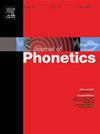口语单词产生中的级联激活驱动不完全中和:基于网络的普通话三变调研究
IF 2.4
1区 文学
0 LANGUAGE & LINGUISTICS
引用次数: 0
摘要
不完全中和发生在两个潜在的对比音在语音上中和,但在语音上仍然不同的情况下(例如,在美式英语中,“later”和“ladder”在中间停顿时成为同音音)。正确理解它是音韵学和语音生成的基础。以普通话三调连调的不完全中和为例(T3 + T3→T2 + T3),利用广义加性建模(GAMM)和生长曲线分析(GCA)证实了这种不完全中和的存在。至关重要的是,我们发现当说话者在说话时被要求同时执行言语工作记忆任务时,这两个音调(T2和T3)变得更加中立;在测试假词时也发现了类似的模式,尽管总体效果较弱。由于并发言语工作记忆任务预计会增加加工负荷并减少口语单词产生过程中的级联激活,因此我们的研究结果表明,级联激活允许上游声学差异在下游声学中浮出水面,从而驱动不完全中和。我们的研究表明,拥抱级联激活可以为围绕不完全中和的离散与范例表示/操作之间的长期争论提供信息。级联激活如何与生成音韵学的核心假设兼容也进行了讨论。本文章由计算机程序翻译,如有差异,请以英文原文为准。
Cascading activation in spoken word production drives incomplete neutralization: An internet-based study of Mandarin 3rd tone sandhi
Incomplete neutralization occurs when two underlying contrastive sounds are phonologically neutralized but remain phonetically distinct (e.g., “latter” and “ladder” become homophonous when the intervocalic stops are flapped in American English). Its proper understanding is foundational to phonology and speech production. Using the incomplete neutralization of the Mandarin 3rd tone sandhi as a test case (T3 + T3 → T2 + T3), we confirmed the presence of this incomplete neutralization with generalized additive modeling (GAMM) and growth curve analysis (GCA). Crucially, we found that the two tones (T2 and T3) became more neutralized when speakers were additionally required to perform a concurrent verbal working memory task while speaking; similar patterns were found when pseudowords were tested, although the overall effects were weaker. Since the concurrent verbal working memory task is expected to add processing load and decrease cascading activation in the spoken word production process, our results suggest that cascading activation, which permits upstream distinctions to surface in downstream acoustics, drives incomplete neutralization. Our study shows how embracing cascading activation can inform the long-standing debate between discrete vs. exemplar representations/operations surrounding incomplete neutralization. How cascading activation is compatible with the core assumptions of generative phonology is also discussed.
求助全文
通过发布文献求助,成功后即可免费获取论文全文。
去求助
来源期刊

Journal of Phonetics
Multiple-
CiteScore
3.50
自引率
26.30%
发文量
49
期刊介绍:
The Journal of Phonetics publishes papers of an experimental or theoretical nature that deal with phonetic aspects of language and linguistic communication processes. Papers dealing with technological and/or pathological topics, or papers of an interdisciplinary nature are also suitable, provided that linguistic-phonetic principles underlie the work reported. Regular articles, review articles, and letters to the editor are published. Themed issues are also published, devoted entirely to a specific subject of interest within the field of phonetics.
 求助内容:
求助内容: 应助结果提醒方式:
应助结果提醒方式:


